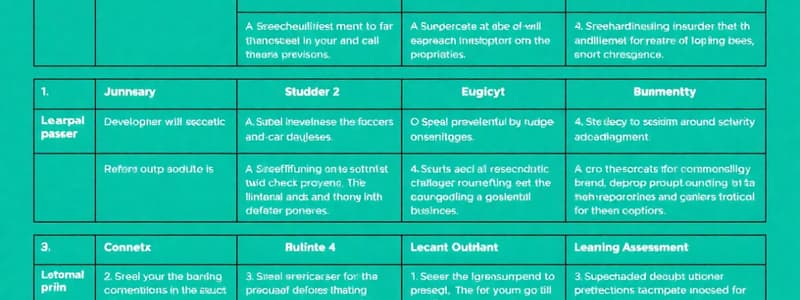Podcast
Questions and Answers
What are the basic steps in developing rubrics?
What are the basic steps in developing rubrics?
There are five basic steps in developing rubrics for assessing students' performance and product.
What is the first step in developing rubrics?
What is the first step in developing rubrics?
Determine the learning outcome and the performance task to be evaluated.
The first step in developing a rubric involves choosing tasks that are essential, aligned with desired learning outcomes, authentic, and meaningful.
The first step in developing a rubric involves choosing tasks that are essential, aligned with desired learning outcomes, authentic, and meaningful.
True (A)
The first step in developing a rubric involves choosing tasks that are complex, feasible, and measurable.
The first step in developing a rubric involves choosing tasks that are complex, feasible, and measurable.
What are the four questions that can guide you in identifying the performance task?
What are the four questions that can guide you in identifying the performance task?
What is the second step in developing a rubric?
What is the second step in developing a rubric?
What should the attributes or indicators reflect?
What should the attributes or indicators reflect?
What is the fourth step in developing a rubric?
What is the fourth step in developing a rubric?
Flashcards
Learning Outcome
Learning Outcome
The desired knowledge or skills students should achieve from instruction.
Performance Task
Performance Task
A specific activity to evaluate student understanding and skills.
Clarity in Assessment
Clarity in Assessment
Clearly defining what is to be learned and evaluated.
Alignment
Alignment
Signup and view all the flashcards
Authenticity
Authenticity
Signup and view all the flashcards
Complexity
Complexity
Signup and view all the flashcards
Feasibility
Feasibility
Signup and view all the flashcards
Measurability
Measurability
Signup and view all the flashcards
Quality Attributes
Quality Attributes
Signup and view all the flashcards
Benchmark Exemplars
Benchmark Exemplars
Signup and view all the flashcards
Focus on Characteristics
Focus on Characteristics
Signup and view all the flashcards
Criteria/Domains
Criteria/Domains
Signup and view all the flashcards
Technical Skills
Technical Skills
Signup and view all the flashcards
Research Report Criteria
Research Report Criteria
Signup and view all the flashcards
Expected Behaviors
Expected Behaviors
Signup and view all the flashcards
Skill Definition
Skill Definition
Signup and view all the flashcards
Learning Measures
Learning Measures
Signup and view all the flashcards
Performance Evaluation
Performance Evaluation
Signup and view all the flashcards
Rubric Development
Rubric Development
Signup and view all the flashcards
Effective Feedback
Effective Feedback
Signup and view all the flashcards
Study Notes
Developing Rubrics
- Rubrics are used to assess student performance and product.
- There are five basic steps in developing rubrics.
Step 1: Determining Learning Outcome and Performance Task
- Clearly define the learning outcome and the specific performance task to be evaluated.
- The task should be:
- Essential (aligned with desired learning outcomes)
- Authentic (involves meaningful real-life application)
- Complex (numerous possibilities for application)
- Feasible (can be completed within time constraints)
- Measurable (can be observed and measured)
- To identify the right performance task, ask yourself:
- What learning outcomes are to be evaluated?
- What student performances/outputs are relevant measures of those outcomes?
- Are all tasks equally important?
- What best represents the expected outcomes?
Step 2: Identifying Quality Attributes
- List potential attributes/indicators of good performance.
- Use personal expectations and examples of good work to identify key standards.
- Focus on the skills, knowledge, and behaviors.
- Limit the characteristics to be evaluated.
Step 3: Determining Criteria/Dimensions
- Group attributes/indicators into categories (criteria).
- For example, in a dance performance task, "Technical Skills" could be a category, including elements like movement, body position, and stage placement.
- Criteria can also include components of a specific performance task (e.g., components of a research report).
Studying That Suits You
Use AI to generate personalized quizzes and flashcards to suit your learning preferences.




